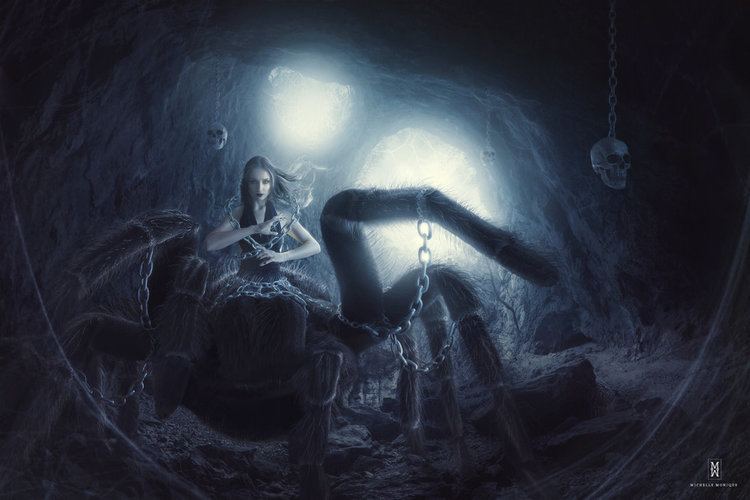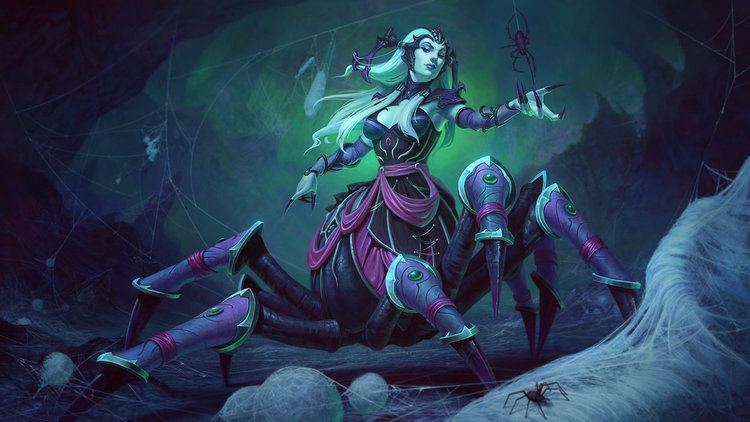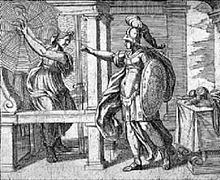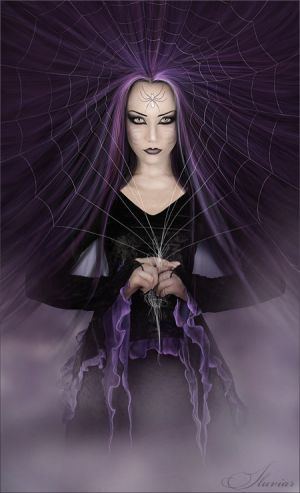 | ||
Similar Ao Guang, Ariadne, Medusa | ||
In Greco-Roman mythology, Arachne (/əˈrækniː/; from Greek: ἀράχνη, cognate with Latin araneus) is a talented mortal weaver who challenged Athena, goddess of wisdom and crafts, into a weaving contest; this hubris resulted in her being transformed into a spider.
Contents
- The Curse of Arachne the First Spider The Story of Arachne and Athena Greek Mythology
- Ovids version
- Athena wins
- Arachne wins but hangs herself
- Influence
- In popular culture
- References

There are many versions of the story's weaving contest, with each saying that one or the other won.
Arachne lent her name to the taxonomic class Arachnida, which includes spiders.
The Curse of Arachne, the First Spider | The Story of Arachne and Athena | Greek Mythology
Ovid's version
One version appears in the Metamorphoses of the Roman poet Ovid.

In this version, Arachne was a shepherd's daughter who began weaving at an early age. She became a great weaver, boasted that her skill was greater than that of Athena, and refused to acknowledge that her skill came, in part at least, from the goddess. Athena took offense and set up a contest between them. Presenting herself as an old lady, she approached the boasting girl and warned: "You can never compare to any of the gods. Plead for forgiveness and Athena might spare your soul."

"Ha! I only speak the truth and if Athena thinks otherwise then let her come down and challenge me herself," Arachne replied. Athena removed her disguise and appeared in shimmering glory, clad in a sparkling white chiton. The two began weaving straight away. Athena's weaving represented four separate contests between mortals and the gods in which the gods punished mortals for setting themselves as equals of the gods. Arachne's weaving depicted ways that the gods had misled and abused mortals, particularly Zeus, tricking and seducing many women. When Athena saw that Arachne had not only insulted the gods, but done so with a work far more beautiful than Athena's own, she was enraged. She ripped Arachne's work into shreds, and hit her on the head three times. In rage, Arachne hanged herself. Then Athena said "'Live on then, and yet hang, condemned one, but, lest you are careless in future, this same condition is declared, in punishment, against your descendants, to the last generation!' After saying this she sprinkled her with the juice of Hecate's herb, and immediately at the touch of this dark poison, Arachne's hair fell out. With it went her nose and ears, her head shrank to the smallest size, and her whole body became tiny. Her slender fingers stuck to her sides as legs, the rest is belly, from which she still spins a thread, and, as a spider, weaves her ancient web. " This showed how goddesses punished those who were mortal.
Athena wins

In this version, someone asks Arachne how she learned to weave so well and suggested that Athena taught her and she didn't know it. Arachne dismissed this and boasted that she could teach Athena a thing or two in weaving. Athena then appeared in the doorway, wrapped in a long cloak, and asked if she really didn't believe that Athena had taught her to weave. Arachne repeated her boast and Athena challenged her to a contest in which Zeus (Jupiter) was to be the judge. Whoever lost must promise never to touch spindle or loom again. Arachne wove a web thin yet strong with many colours. This was no match for Athena's weaving, made up of the gods and their glory, shining with their beauty.
Arachne acknowledged Athena's triumph, but despaired at the loss of her craft. Athena saw that Arachne could not live if she could not weave, so she touched Arachne with the tip of her spear, turning her into a spider so she could weave without spindle or loom.
Arachne wins but hangs herself
In this version of the myth, Arachne was a blessed weaver of Greece. People asked her if she had been taught weaving by Athena herself, the goddess of wisdom. Although this was meant as a compliment, Arachne became angry. She thought that her skill was greater than the goddess's. Hearing of her attitude, Athena appeared on her doorway disguised as an old woman in a dark cloak. She asked her to respect the gods and goddesses, but Arachne just laughed, and said that even if Athena herself challenged her, it would be an easy win. Athena then revealed herself and challenged Arachne to a competition. The loser would promise never to weave again.
Athena wove a tapestry of the people of Greece, with Poseidon and Athena over them, deciding whose name should be given to the city of Athens. Arachne wove a tapestry about Zeus, and his seduction of Europa and others. Athena saw that although Arachne had insulted the gods, her work was so beautiful that Athena herself was awed. She realized that Arachne couldn't live without weaving. To make Arachne realize her mistake and also to teach her to respect the gods and their works, she touched Arachne's forehead with the tip of her hand. The magic worked only partially, filling Arachne with guilt for her insolence, and she hanged herself. Out of pity, Athena brought Arachne back to life as a spider, so that she and her descendants could weave all their lives.
Influence
The taxonomical class name Arachnida and the name for spiders in many romance languages are both derived from arachne.
The metamorphosis of Arachne in Ovid's telling furnished material for an episode in Edmund Spenser's mock-heroic Muiopotmos, 257–352. Spenser's adaptation, which "rereads an Ovidian story in terms of the Elizabethan world" is designed to provide a rationale for the hatred of Arachne's descendent Aragnoll for the butterfly-hero Clarion.
The tale of Arachne inspired one of Velázquez' most factual paintings: Las Hilanderas ("The Spinners, or The fable of Arachne", in the Prado), in which the painter represents the two important moments of the myth. In the front, the contest of Arachne and the goddess (the young and the old weaver), in the back, an Abduction of Europa that is a copy of Titian's version (or maybe of Rubens' copy of Titian). In front of it appears Minerva (Athena) at the moment she punishes Arachne. It transforms the myth into a reflection about creation and imitation, god and man, master and pupil (and therefore about the nature of art).
It has also been suggested that Jeremias Gotthelf's nineteenth century novella, The Black Spider, was heavily influenced by the Arachne story from Ovid's Metamorphoses. In the novella, a woman is turned into a venomous spider having reneged on a deal with the devil.
